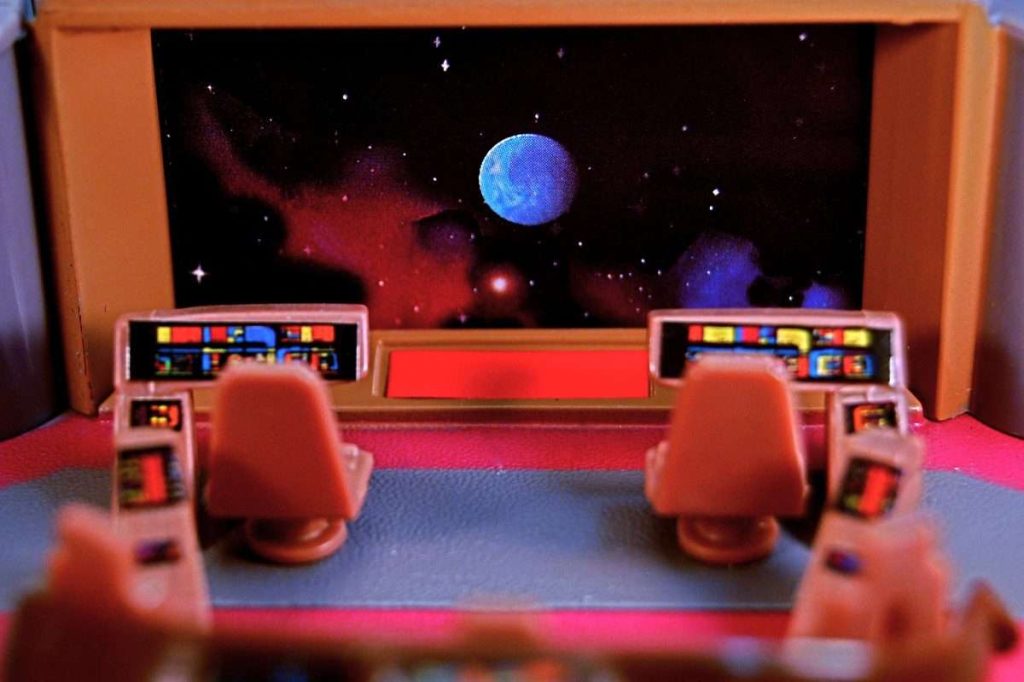The modern business environment has something in common with your local sports bar or favorite sci-fi TV show—there are flickering video screens everywhere. The business uses of live and asynchronous video have skyrocketed. It’s revolutionized how people interact, learn, develop, and even create iconic brands. Whether it’s a client discovery meeting or an HR training seminar, the chances are high that the communication is happening on video, and in 2024, this video trend is only expected to increase.
The result is that more and more enterprise-level organizations are creating videos. In the last three years, 76% of marketing teams have invested in video production. Virtual classrooms, webcasting, and video streaming are all used as training tools by 88% of businesses. A recent study by HubSpot found that 37% of companies exclusively produce their own video content in-house, 14% utilize an agency, and 49% combine in-house and agency production.
With so much video being produced by companies for different use cases and audiences, the challenge is finding a centralized way to securely create, manage, and distribute multiple use-case videos across the globe. The answer is to employ an Enterprise Video Platform (EVP). These powerful software platforms offer a single, end-to-end solution for delivering video experiences over large networks, to any device at any time.
Let’s take a deeper look into EVPs, why businesses use them, and the top eight enterprise video platforms for 2024.
What are enterprise video platforms?
Enterprise video platforms are video content management systems specifically designed to assist enterprise-level businesses in managing, hosting, storing, and distributing videos. An EVP usually offers broadcasting features, production and editing capabilities, on-premise or cloud video hosting, and robust security features. They also include a variety of 3rd-party integrations with commonly used business software, such as meeting platforms, content management systems (CMS), content delivery networks, and sales and marketing platforms.
EVPs include an array of monetization options and advertising control, allowing increased ROI on videos distributed through the system. They are commonly used for corporate learning and development, live streaming, customer support, and other functions needed for business operations.
The focus on business and B2B solutions is an important distinction between EVPs and similar Online Video Platforms (OVP) like YouTube or TikTok, which are oriented toward consumers or B2C. But it’s not the only reason that EVPs are a superior choice for companies.
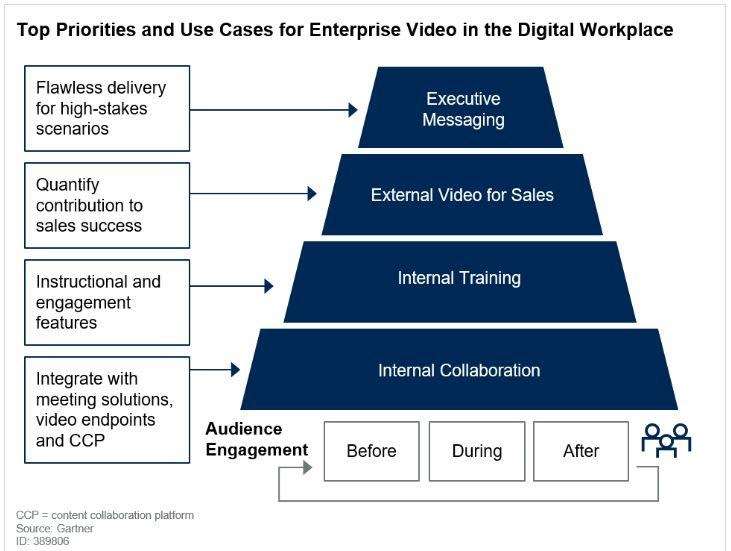
Why Businesses Use Enterprise Video Platforms
There are several advantages for businesses to use an EVP over an OVP. Online video platforms are not designed to solve specific business problems or to meet an organization’s business requirements. Content posted on OVPs is subject to rights issues and potential blocking by software, networks, or foreign countries. OVPs lack comprehensive security features and technical support, and are not designed for collaboration.
The inability to access, sort, or manage valuable videos is one of the most concerning collaboration issues for businesses. This problem is solved with an enterprise video platform that provides centralized, secure video asset management. EVPs increase the effectiveness, scalability, and security of enterprise video. They give an organization the tools they need to design a seamless, customized buyer experience that increases engagement, creates a full pipeline, and shortens deal cycles.
Users can also access a variety of video use cases, such as e-learning video, employee training, company meetings, video walkthroughs, and more. These, in turn, have the potential to greatly improve corporate activities and results across the enterprise.
One of the main selling points of EVPs is live streaming, which has become a significant part of business communication. A survey by Haivision revealed that 55% of businesses use live video for in-workplace broadcasts, while 29% stream live video daily. Having its own secure, controllable platform for streaming critical business information to offices worldwide is a significant advantage for an enterprise instead of relying on a consumer OVP.
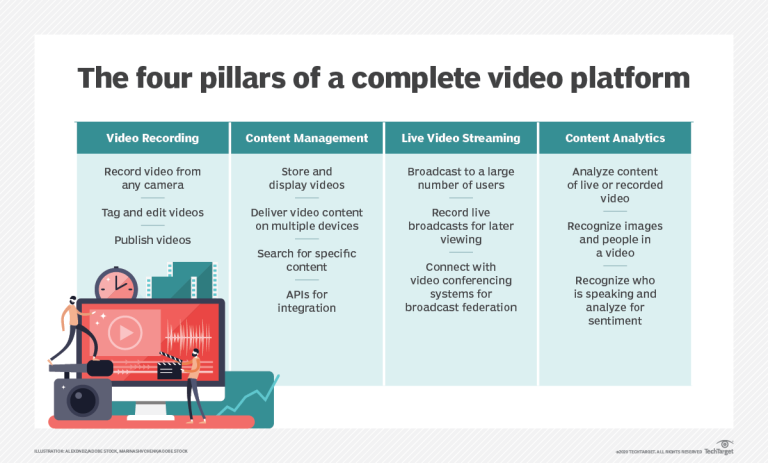
How to Choose an Enterprise Video Platform
When choosing a high-end EVP, the following features should be sought out:
- Analytics – Comprehensive analysis of performance by monitoring video and engagement data via analytics dashboards
- APIs and SDKs – Create custom video integrations with existing business software and apps.
- Branding Options – White-label service includes a customizable player, and adding the user’s company branding to video content.
- Content Delivery Network (CDM) – Multi-CDN with reduced latency and buffering, allowing upscaling of high-quality live streaming
- Content Management – An easily searchable video library where videos can be viewed on any device; real-time transcription and translation functionality
- End-to-end Functionality – A single solution to address all required use cases; flexible and can evolve with changing business needs and growth
- Live Streaming – Secure broadcasting to many users at multiple locations, simulcasting, live stream recording, and company video conferencing system connectivity
- Monetization Features – Supports ad-supported (AVOD), subscription-based (SVOD), and pay-per-view (TVOD) monetization models
- Security – Data security features including dynamic watermarking, encrypted video streaming, IP restrictions, multi-user management, video DRM
- Storage – Onsite or cloud video storage library
- Video Recording – The ability to record pro-quality video on any camera, edit and publish it; add music and effects, branding, graphics, and tags.
Be sure the EVP you choose meets your organizational needs while leaving room to evolve with future growth. With these qualifications in mind, here are the best eight EVPs on the market today.
Top 8 Enterprise Video Platforms for 2024

TargetVideo is an EVP focused squarely on video monetization. The platform boasts a lightweight HTML5 player, uses a reliable CDN and offers a range of content management tools, such as analytics and ad-based monetization. The platform includes many features aimed at producing ads employing the latest technology, including VAST & VPAID ad tags, waterfalling, and Google IMA SDK integration.
Pros:
- Supports live streaming and VOD
- Real-time ad analytics suite
- Complete publishing infrastructure: CDN, encoding, and hosting
Cons:
- Doesn’t support SVOD and TVOD monetization
- Advanced ad features are mostly available only on the Premium plan
- Doesn’t support for VR and 3D videos
Pricing: With a free option available for those who want to give a try first, custom-tailored plans are also available priced according to the organizations specific needs.
Reviewer Says: “While it works great as a video player/platform, the downside is poorly managed live streaming.”
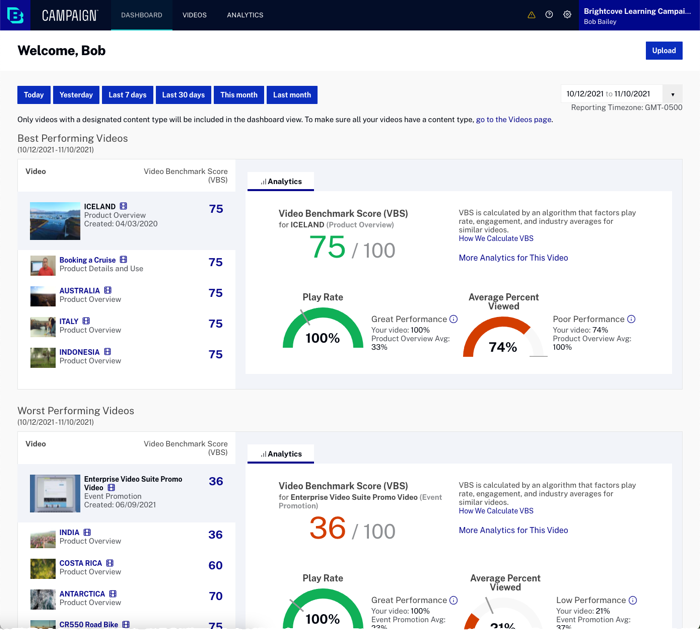
Brightcove is an industry-leading EVP that offers corporate communications, enterprise video hosting, live HD streaming, marketing-focused integrations, and many more services. It’s been commended for its immediate usability, but it can also be customized. The platform supports all monetization models and is even optimized for mobile.
Pros:
- Versatile platform with everything needed
- Excellent tools for audience engagement
- Easy to create playlists and upload/edit videos
Cons:
- Few automation tools
- Not the best platform for sales enablement
- Pricing is not transparent
Pricing:
Brightcove rolls out a range of dynamic plans for marketers and enterprises but keeps its pricing under wraps. Get in touch with them to arrange a free trial and receive a custom quote.
Reviewer Says: “Very great for public facing videos out of the box, more difficult (but not impossible) for single sign-on and private/intranet videos.”
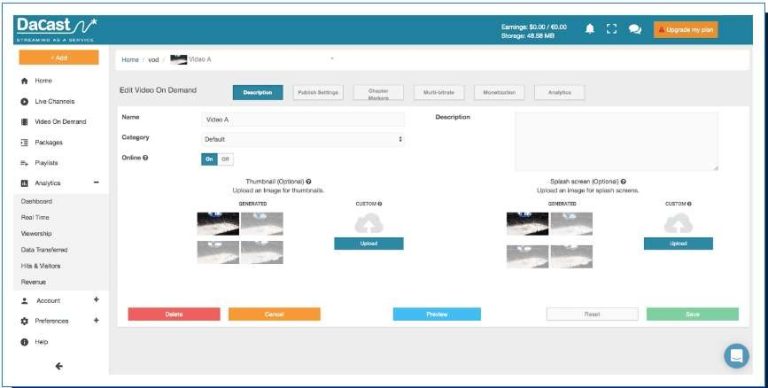
Dacast’s EVP is best known for being one of the few American video platforms accessible in China. Users can enjoy cloud transcoding, lag-free adaptive bitrate streaming, private video hosting, and a variety of live stream monetization services on this white-label platform and streaming solution. It’s considered an upcoming EVP that is improving over time.
Pros:
- Global CDN
- High-quality live streaming
- Easy to learn and start using right away
Cons:
- Difficulty in managing multiple channels
- Cheaper plans have less storage
- Analytics are frequently not accurate and confusing
Pricing: There’s a plan for everyone with three primary tiers: the Starter plan at $39/month for smaller audiences, the Event plan at $63/month designed for one-time or infrequent events, and the $165/month Scale plan, perfect for business and organizational videos. For those with high-volume needs, a Custom solution is also available. Want to test it first? Take advantage of the 14-day free trial.
Reviewer Says: “Dacast video streaming service is accessible from China, so we choose Dacast over the other more well-known and proven competitors.”
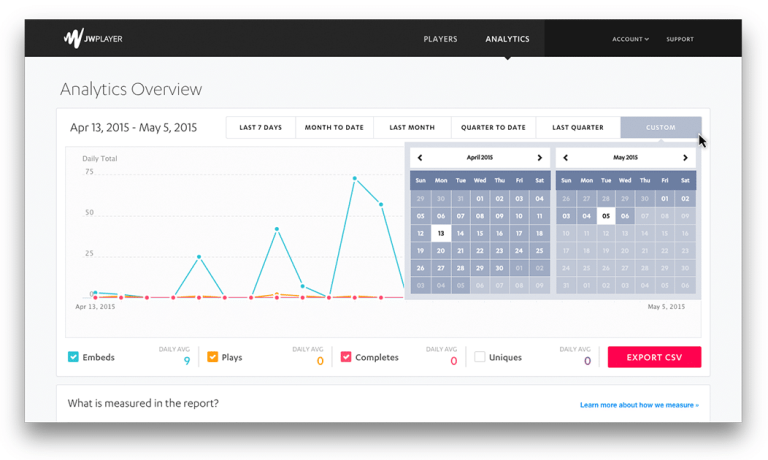
JW Player is an industry pioneer that has grown from a simple video player to a full-fledged EVP offering content management, live streaming, video hosting, and engagement features. A complete video platform for any number of enterprise use cases, it boasts AI content matching, OTT support, and adaptive streaming that allows fluid playback across any bandwidth scenario or device.
Pros:
- Live Channels that allow fast broadcasting and monetization of live streams
- Intuitive UX
- Hosting and content delivery flexible, with low costs
Cons:
- Customer support issues reported
- One year advance payment required, minimum
- Analytics are somewhat cumbersome and not user-friendly
Pricing: Following the 30-day free trial, you’ll need to get in touch with JW Player’s team to set up a personalized account and receive a customized pricing plan that will be crafted to suit your requirements.
Reviewer Says: “We spent a lot of time looking for an affordable, reliable video hosting system, and JW stood out in a crowded field.”
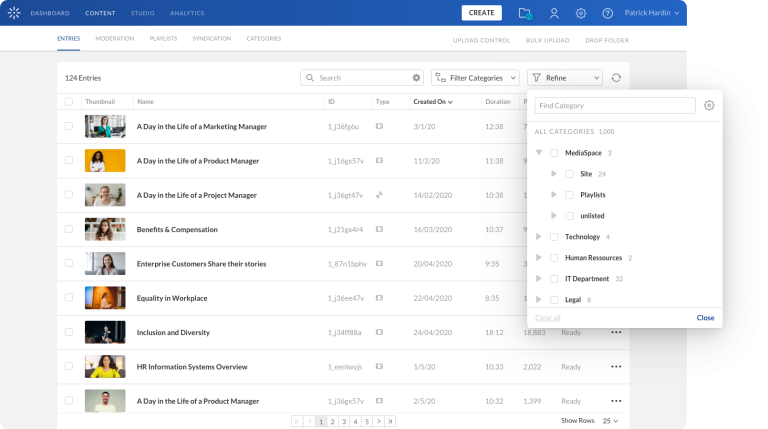
Kaltura’s EVP platform is a highly versatile unicorn in the marketplace. It offers a variety of services for different types of broadcasters and uses, particularly for ecommerce brands, e-learning, and governments. Unlike other solutions, Kaltura is open-source and boasts a large user community that crafts custom integrations and plugins. Outside of these quirks, it’s a popular platform with most features an enterprise needs for video content management.
Pros:
- E-learning and virtual classroom features are state-of-the-art
- Intuitive video library management
- Allows for simultaneous screen recording and presentations
Cons:
- It does not have built-in monetization but can be customized to have it
- No built-in hosting
- Customer service is not real-time and has been poorly reviewed
Pricing: Kaltura’s pricing structure is somewhat complex. They offer nine distinct packages, including virtual classroom, virtual events, media services, video portal, webinars, town halls, video management console, video messaging, and meetings, each with its own set of plans, prices, and features. However, Kaltura only reveals the pricing for a selection of these packages with some including a free trial.
Reviewer Says: “The workflow around the various platform products is very mature and well integrated.”

Vidyard’s EVP was created with marketers in mind, being sale-driven. The platform is equipped with all the tools and information required to increase audience engagement, drive prospects through the sales process, and assess the true ROI of videos. It makes it simple to create and distribute personalized videos at every point of the sales cycle, from prospecting to proposals. Vidyard easily integrates with commonly used sales and marketing tools such as Salesforce, Marketo, and Pardot.
Pros:
- Excellent analytics and flexible reporting
- Includes email, personalization, and SEO tools
- Broadcasting features are pro-quality and comprehensive
Cons:
- The backend editing portal is complicated
- UX is not always intuitive and can be clunky
- No option to make videos private
Pricing: With a free plan available as a great way to start, there are three additional plans available. Starting at $19/month with a 14-day trial, businesses have access to unlimited videos, viewer insights and other additional features. The Plus plan at $59 per month offers advanced features for the whole team. A custom-priced Business plan offers all features as well as video strategy with integrations, advanced security, workflows, and other optional add-ons.
Reviewer Says: “Incredible integrations and ability to drive engagement with outbound sales enablement campaigns.”
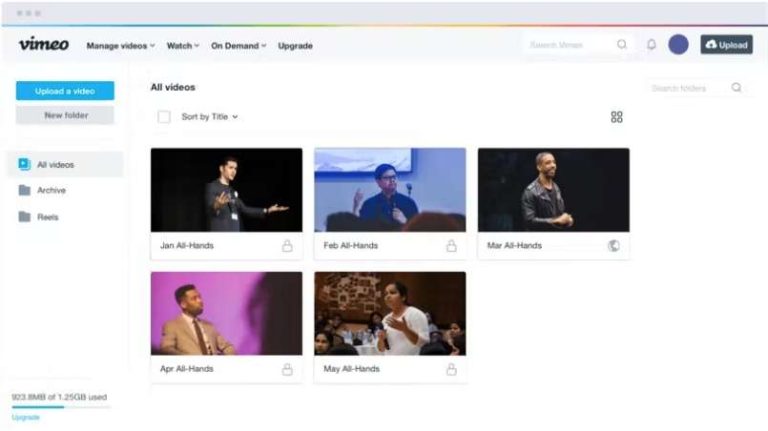
While many are familiar with Vimeo’s ubiquitous OVP, the company also offers a suite of enterprise video services. Vimeo Enterprise is a powerful video management platform that facilitates live streaming and interactive video events. Key features include automated Zoom uploads, expansive cloud storage, broad privacy controls, marketing tools, and monetization options.
Pros:
- A massive global user base allows for an extensive reach
- Numerous useful 3rd party integrations
- Very high-quality video resolution
Cons:
- Server-level connectivity can be unreliable, with longer buffering times
- Some services are priced separately, and many undisclosed fees
- Archived events only have basic editing features
Pricing: After trying Vimeo for free, businesses can select one of the four tiers priced per seat/per month, all including a free trial. The Starter plan is priced at $80 per seat/month, Standard at $233, and Pro at $342. A customized Enterprise plan is available upon inquiry.
Reviewer Says: “Vimeo makes it easy to upload and edit your videos. You can also upload in high quality, and Vimeo always delivers with retaining the quality during streaming.”

VPlayed provides enterprises with an online media platform that gives users total control over the distribution, marketing, and broadcasting of video or audio projects. The EVP boasts adaptive streaming, multiple media formats, unlimited storage, a content partner site, and secure access control, among its many features. It has advanced tech to deliver content on live streaming, video on demand, and OTT channels.
Pros:
- Secure and scalable
- Includes built-in social distribution and marketing features
- Supports comprehensive monetization models
Cons:
- No free trial offered
- The analytics dashboard could use personalized metrics and further enhancements
- Tracking for live and on-demand users may be inaccurate
Pricing: To receive a detailed breakdown of pricing customized for your unique requirements, contact VPlayed.
Reviewer Says: “Overall, VPlayed works fantastic and is very helpful for enterprises to generate revenue out of their video assets through multiple monetization models.”
Create Compelling EVP Content with Hour One
Enterprise video platforms are an ideal solution for large organizations that need to manage and distribute a lot of video content through different channels and for various use cases. As an end-to-end video content management system, they simplify what can be an overly complex web of video streams, e-learning seminars, social media reels, and more. What still isn’t simple for most enterprises is creating all that content in the first place. That’s where Hour One’s AI video generator comes in.
Hour One is a powerful, easy-to-use, and affordable solution that employs the latest in AI tech to quickly create hyper-realistic human avatar-led videos for any use case at scale. Simply choose a template and layout, select a character and voice, enter text from a document, PowerPoint, or article, and click a button. Almost instantly, you have a sharable video that you can use to explain anything or train anyone. Combining an enterprise video platform with an AI video generator creates an unstoppable, high-ROI video marketing and communication machine that’s highly engaging and tough to beat.
Try creating your first video today for free to see how an AI video generator will help grow your enterprise.
Enterprise-level organizations now use video for marketing, training, internal communication, social media, and more. Enterprise video platforms are video content management systems that offer a single, end-to-end solution for delivering video experiences over large networks to any device. EVPs are designed to assist businesses in managing, hosting, storing, and distributing videos. We’ve surveyed the top eight solutions in this post. Combining an EVP with an AI video generator such as Hour One is a high-ROI solution.





